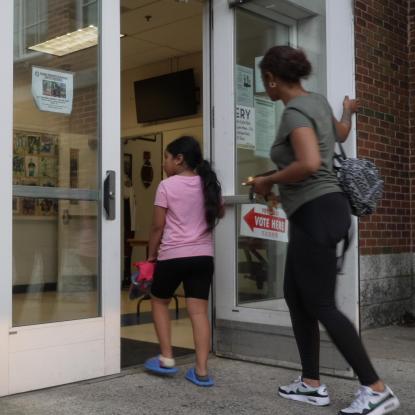Additional Resources
If you have questions about this policy proposal, we'd love to hear from you! Just e-mail us.

The freedom to vote depends on meaningful voter access. For many voters, that means casting their ballot in-person at a polling location on Election Day or during early voting.
Voters should be able to vote in-person at a time and location that is convenient and accessible for everyone in a community, and in-person voting access should be equitably distributed across our communities. Voters in the community should have a voice in shaping decisions about polling locations and access.
Attacks on In-Person Voting Access
Voting in-person remains the most popular form of voting—either on Election Day or during a state’s early voting period. Even during the 2020 elections, where more people voted by mail or voted early than ever before, 54 percent of voters still voted at their polling place on Election Day. Voters with disabilities, elderly voters and communities of color are all groups that traditionally rely on in-person voting to cast their ballot.
But across the country, voters experience long wait times and general confusion at the polls due to last minute location changes or changes to where voters are assigned, as state and local governments allocate fewer resources to in-person voting.
And these problems do not affect all voters evenly. Under-resourcing of polling locations, wait times, and polling place changes and closures all occur at higher rates in communities of color. The Supreme Court’s decision in 2013 in Shelby County v. Holder – which gutted the provision of Voting Rights Act that prevented many discriminatory voting laws from going into effect –seriously exacerbated this problem. Unfortunately, many localities across the country have taken full advantage of this lack of federal oversight to impose hard-to-spot practices that create barriers for marginalized voters in every election.
Barriers to In-Person Voting
State and local governments, now free from the Voting Rights Act of 1965’s preclearance provisions, have dramatically reduced the number of locations to vote in-person on Election Day and during early voting. In Louisiana, for example, parish governments closed a total of 126 polling places between 2012 and 2018. In Mississippi, county governments closed a total of 96 polling places between 2012 and 2018. And in Alabama, county governments closed a total of 72 polling places during the same time period. States like Iowa and Georgia have recently reduced the number of early voting days for elections, creating an additional barrier to in-person voting.
Across the country, voters reported long wait times and confusion about where to vote during the 2020 election. In general, voters of color have consistently reported longer wait times at the polls in the last several elections since Shelby County. The removal, consolidation, or relocation of a polling place in a neighborhood can cause substantial voter confusion when voters show up to the wrong polling place. And longer wait times tend to occur in places where officials have closed or consolidated the number of polling places available to voters, reducing the total number of voting resources available to the public. As studies have shown, neighborhoods of color have experienced polling place closures at higher rates than white neighborhoods. Polling places that serve voters of color are also less likely to have the resources needed to provide for an efficient voting experience, including poll workers and voting machines. As a result, Black and Latino voters are more likely than white voters to experience long wait times at the polls.
The lack of access to an Election Day polling place is especially harmful in states that require voters to vote in their assigned precinct. As advocates demonstrated in Brnovich v. DNC, Black, Latino, and Native voters are more likely to be disenfranchised by what are called “out-of-precinct” bans. This is because they are more likely to experience a change to their polling place, and then not be able to cast their ballot at their old location (or have time to travel to cast their ballot at their new location). Other studies have shown similar disparities with respect to the distance to travel experienced by voters of color to their polling places compared to white voters.
Likewise, a lack of access to early voting reduces the opportunity for marginalized communities to vote, since marginalized communities tend to use early voting at higher rates. In states that do not provide universal access to vote by mail, most voters must vote in-person to exercise their right to vote.
Advocating for Better In-Person Voting Access
Voting in person is the only form of voting available to all eligible voters, and we must ensure equitable access. However, tracking in-person voting problems can be difficult because the decisions are hyperlocal, changes often happen at the last minute, and there are simply too many places to monitor all at once.
Voters in communities are in the best position to tackle problems with in-person voting and advocate for better access, because local advocates can learn in real-time when problems arise, and leverage community contacts to demand accountability from local decision-makers.
Local advocates can implement a number of strategies, including:
Additional Resources
If you have questions about this policy proposal, we'd love to hear from you! Just e-mail us.